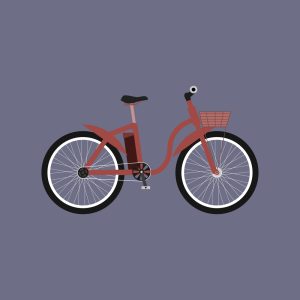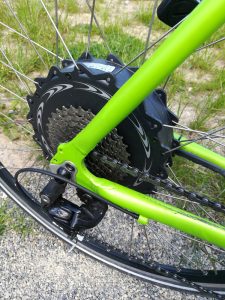The craze for the electric bike has increased its demand worldwide. With the increasing demand, many manufacturers have started designing and developing electric bikes with new and developed features. Hundreds of electric bike models are available in the market with varying features and gadgets included.
A person starting his journey with an electric bike will need help choosing among the abundant models that would suit him. With a proper understanding of the gadgets and designs infused with electricity, he can choose a better one. One of the main things to consider is how the motor works.
Motor transfers the current from the battery to the bike parts that need the power to propel the electric bike forward. The motor of an electric bike does the job of an engine in a motorbike. Using the energy provided, they move the bike forward. Motors are of three types: mid-drive, hub-drive, and friction motors.
Mid-drive motors are installed in the bike’s center, between the pedals. You can find these motors in expensive bike models. With support from the pedaling or rear, the motor spins to propel the bike.
Hub-drive motors are seated on the front or rear hub and are of two types. Direct drive hub motors and geared hub motors. Direct drive hub motors are gearless motors that use magnetic force to operate the motor. Geared hub motors use planetary gears to control the speed.
While friction motors are connected to the rear tire to propel the bike. It is the cheapest motor to buy, and most new bikes do not use this type of motor anymore; due to its less efficiency and heavy. But it is a cheap way to electrify a traditional bicycle. This motor can wear the tire soon, but you can easily change it between bikes.
Electric bikes use these motors, but they mostly come with direct drive or geared hub motors. One should know their motors when purchasing an electric bike to acquire a better experience. Therefore, we will discuss the pros and cons of the two hub motors; you can purchase the one that best fits you.
Direct drive hub motors.

Direct-drive hub motors are the simplest motors on electric bikes. They have no gears but copper winding coil. To conduct power, direct-drive hub motors use a copper winding coil that creates magnetic force. The transmission of power is conducted without a gear. Therefore you can also call it a gearless motor. It is called a direct drive hub motor as it directly drives the load.
They are large and take up more space on the electric bike. These motors are suitable for high-speed bikes that need fast starting and braking. As direct drive hub motors only need low torque to start up the bike, starting the bike with high acceleration is possible.
Class 3 electric bikes fall under motorcycles and can use the motorway. When using the highway, a direct drive motor will be a better option to start the bike with its high acceleration starting with low torque. And riding the electric bike on the road will also have the use for the sudden brake.
According to the physics law, any energy used will not go wasted but converted into another energy. To prove the statement right, regenerative braking comes into the picture. Using the electric brake of the electric bike, the rider can save up some of the energy used to propel the bike forward. By saving some energy, you can recharge your battery. But you must know that the energy gained is only around 10% of the energy used. Still, it is better than nothing.
Direct-drive hub motors are bulkier and can drag the electric bike. When using the electric side of the electric bike, the rider will not notice the weight of the motor. But when the battery dies or the rider plans to use the pedals without pedal assist, he will notice the motor’s weight. When the bulky weight of the direct drive hub motor adds to the already heavy frame of the electric bike, it can be tiring to the rider.
To climb downhills the steep roads, you can use the electric brake. The rider can often brake without tearing or wearing off the brake. With the better quality electric bike, direct drive hub motors will be able to stay attached longer and perform well. But if attached to a low-quality model, it can come off the bike.
Pros;

No noise –
Direct-drive hub motors do not make a noise like geared hub motors. It is a better choice if loud noise is a problem for the rider.
Speed –
Direct drive motors can start with acceleration and the speed the rider wants. It is a good choice for a fast electric bike. Class 3 electric bikes’ speed limit is 28 mph, and they can use the main road. As the propelling speed of the electric bike depends on the speed of pedaling or the motor, a motor with a fast start will be a better option. Starting the electric bike with accelerated speed is better when riding on the road. You can also come to a sudden stop quickly.
Less wearing off –
As direct drive hub motors have fewer moving parts, the wearing off of parts is less. These motors are fixed using the magnetic shell to stay firm on good-quality bike models. But if used in low-quality models, it will come off soon. It can be used extended when fixed in a good-quality bike model.
Regenerative braking –
The regenerative braking system uses the energy passed through the motor and transfers it to the battery to recharge it. When the rider uses the electric braking of the electric bike to slow down or come to a halt, regenerative braking is on. This method partially recovers the energy used to propel the bike. Though the energy that the battery is recharged with the regenerative brake is far less than the energy used up, it is a gain to the rider.
Electric brake –
When climbing downhills on steep paths, using the brake is high due to control the electric bike from crashing down too fast. When using the electric brake, the chances of the brake wearing off is less, and you do not have to worry about the sudden breaking of the brake.
When using the brake often, it can heat the brake. You can avoid it with the electric brake. A direct drive hub motor will be a better choice if the rider has to ride on steep paths too often.
Cons;

Heavy –
The direct drive hub motors are heavier and bulkier. It would not be a problem when using the electric side of the electric bike it would not be a problem as the rider will have assistance in riding it. But the electric bike will weigh high when the rider plans to pedal without assistance if the battery dies. The weight of the direct drive motor will add to the already heavy frame of the electric bike. Due to its weight, it can slow down the rider and exhaust him fast.
Size –
Direct-drive hub motors are large when compared with geared hub motors. They take up space in the rear hub of the electric bike. If these motors are fixed on low-quality models, they will come off quickly.
Battery life –
Direct drive hub motors directly propel the electric bike forward; to do this, they need a mechanism. To power up its mechanism, more energy is needed. Therefore, compared to the geared hub motors, the energy is taken from the battery to operate and propel the bike forward is high.
As the direct drive motors also propel faster to reach it, more energy is used. Therefore, the battery used in the electric bike with a direct drive hub motor dies faster than from the geared hub motor electric bike.
Therefore, the distance covered in one battery cycle is less compared to the geared hub motors, and the range is low.
Pricey –
They are expensive with the features of direct drive hub motors, including; a fast, regenerative braking system and the high-quality materials used in preparing the direct drive hub motors.
Well-made direct-drive hub motors can be expensive as they will include a regenerative braking system.
The materials used to design and manufacture the direct drive hub motors are expensive, which adds to the price the customer has to pay.
Geared hub motors.

Geared hub motor transfers the energy to the hub and the wheel with the help of gears. It uses multiple gears to propel the electric bike forward. The geared hub motor makes noise and can be intimidating to some riders. But manufacturers are designing their new models with less noise, and only test riding them will we be able to find out.
As the design of geared hub motors is small, it does not take up huge space in the rear hub. It weighs around 2-4 kg and does not add much weight to the electric bike. When the rider uses the electric bike to pedal with his power or when the battery does, the rider can be fearless about the bike dragging him. As it does not add more weight to the already heavy frame of the electric bike, tiring up the rider is less in comprising to the direct drive hub motors.
The speed of the electric bike depends on the rider’s pedaling power or the motor’s power. With high torque, the bike will not have an accelerated start and will be slower than the direct drive hub motor electric bike. With high torque and multiple gears in use, geared hub motors can better use the battery. With less energy from the battery, the electric bike will be able to cover more distance. The range is high when you compare it with the direct drive motives electric bike.
The manufacturing cost is low because the geared hub motors are not made using high-quality materials. Therefore, the riders will pay low prices to purchase these motors.
Pros;

Small –
Geared hub motors are small and occupy little space compared to direct drive motors. Manufacturers are designing it smaller in the new models to save up space in the central area of the electric bike. As geared hub motors have small diameters, they will not take up more space and hinder the rider when pedaling.
Weight –
These geared hub motors are lighter when compared to direct drive hub motors. As the gear is within the hub, it allows the energy to pass discretely.
Geared hub motors only weigh around 2-4 kg. If the rider wants to use the pedals or the battery is dead, the rider will be able to pedal the electric bike without extra weight dragging them. Compared to the direct drive hub motored electric bikes, geared hub motored electric bikes will have a less exhausting ride without assistance from the electric side of the battery.
Cheap –
As the design of the geared hub motor is less complex and does not need expensive materials, manufacturing them is cheap. Therefore, customers can buy these motors at a lower price than the direct drive hub motors.
Battery life and range–
Electric bikes use the energy derived from the battery to power up the motor. Motor using the energy operates the electric bike and transfers the energy to all the electric parts that need the energy to function. The battery energy used depends on the motor and its function. As geared hub motors do not start up or propel fast, the energy used is less than the direct drive hub motors.
Geared hub motors propel the bike forward with the support of gears in the mechanism. Therefore energy use is limited. With one battery charge cycle, geared hub motors can cover longer distances than direct drive hub motors. Therefore, the range is high.
High torque –
Geared hub motors have high torque application with low speed. Therefore, it is suitable for class 1 and 2 electric bikes.
As they generate high torque, you can use the geared hub motor electric bikes to climb steep downhill, though the direct drive hub motor should be in a heavy vehicle to climb the steep downhill.
Cons;

Noisy –
Geared hub motors can be noisy, and some riders find it intimidating. Manufacturers are trying to design and develop geared motor hubs with less noise. In the future, these motors will be less noisy and intimidating.
Wear off soon –
With multiple gears on work to propel the electric bike forward, the chances of gear hub motors wearing and tearing are higher than the direct drive motors.
Direct-drive hub motors have less torque, and geared hub motors have high torque. It can also be a reason to wear ofc the motor soon. It can take time to wear off with high-quality gears and materials.
When carrying heavy loads or heavy weighing person riding them will need more workings on the gear to propel the electric bike forward; therefore, it can wear off the motor too soon.
Speed –
The electric bike’s speed depends on the rider’s motor or pedaling power. The geared hub motors need more pedaling to propel the electric bike forward. Even then, the speed of the geared motored electric bike will be less than the direct drive hub motor electric bike.
Conclusion.

Electric bikes are differentiated from traditional bikes with the inclusion of a motor and a battery in electric bikes. Depending on the quality and the performance of the motor and the battery, one can evaluate the performance of the electric bike.
Electric bike motors are of three types; mid-drive, hub-drive, and friction motors. New electric bike models use hub-drive motors of two types; direct-drive hub motors and geared hub motors.
Riders familiar with electric bikes and their motor will be fine choosing the suitable motor with their electric bike. But riders new to the electric bike concept will want to know the difference between them to choose appropriately. By weighing the pros and cons of each motor, it will be easier to make the decision.
Speed depends on the motor or the pedaling speed of the rider. If you want your electric bike to be fast and have a high accelerating point when starting, a direct drive hub motor is a better choice.
Battery life in one cycle is high in geared hub motors as they use minimum battery charge to propel the bike forward. In comparison, direct-drive hub motors use more energy to go fast on motorways.
. Range depends on the battery life as the distance covered using the electric bike with geared hub motors will be higher than the direct drive motors.
The geared hub motor size is smaller than the direct drive motors.
The direct drive hub motor weight is higher than the geared hub motor. It usually affects the ride without the battery’s assistance.
The price depends on the materials used in the manufacturing of the motors. Geared hub motors are cheaper than direct drive hub motors.
The rider can choose according to his need by comparing the geared and direct drive hub motors.
